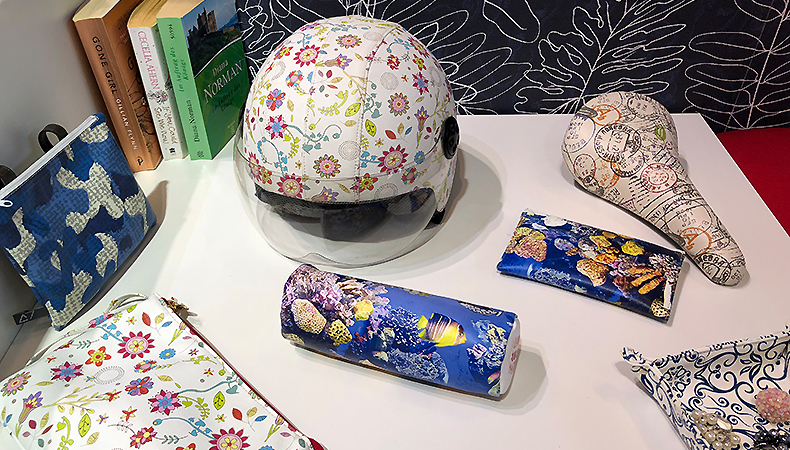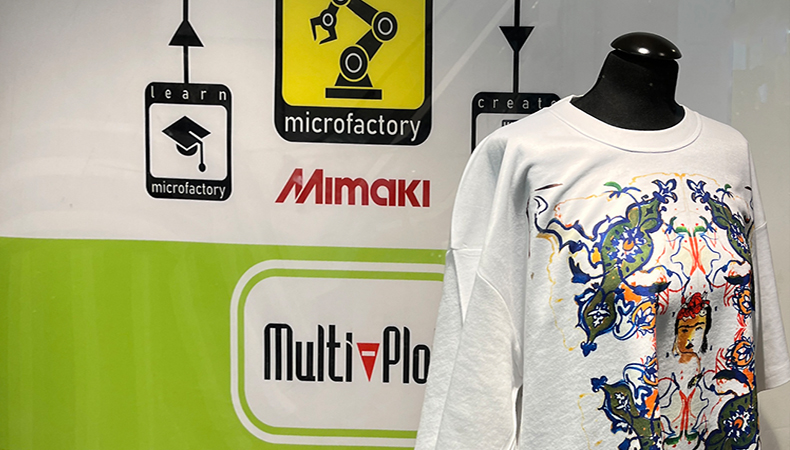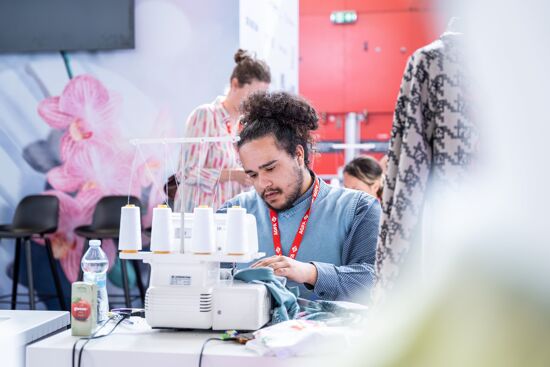The Microfactory – A Future Opportunity for the Printing Industry

The concept of the microfractory may not be new, however it is more important than ever. Printers are in an ideal position at the forefront of this next transformation of industrial production.
Anyone who visited the central Königsgalerie shopping centre on Friedrichsplatz Kassel during the Documenta 15 art festival were able to experience a textile microfactory, where art prints, textile designs and fashion were created right at the “point of art”.
The products created by an interdisciplinary team from Moving School e.V. and the Cologne fashion designer CHANG13 were showcased on the “Social Catwalk”. The technical implementation was carried out by the experts for digital textile printing systems Multiplot Europe GmbH.
With the support of Mimaki, a TS100-1600 textile printer with Sb610 inks was installed. The sublimation inks are Oekotex 100 compliant and extremely colour brilliant. The motifs were transferred to recycled polyester from Georg-Otto-Friedrich and Greentex using a Heatjet 70evo5 calendar. The manufacturers provided these as sponsors for the project, and sublimation paper specialist Kaspar Papir contributed the transfer paper.
For Multplot Europe GmbH, Documenta 15 was not the first Microfactory. Since the mid-2010s, the Kassel-based company had already showcased various installations at trade fairs for fashion and sports articles as well as home textiles.
 CAPTION: Microfactories can be used to produce many consumer products. Image credit: S. Angerer
CAPTION: Microfactories can be used to produce many consumer products. Image credit: S. Angerer
The Microfactory and printing
Textile Microfactories are the production facilities most well-known by the general public. Some examples of these are small production lines or kiosks for garments. This is down to every T-shirt kiosk in a mall or ever sporting goods retailer decorating shirts to customer specifications. Equally this is most known as an apparel microfactory.
The concept of a microfactory was first introduced in the early 1990s. This was within the Japanese automotive industry to enable custom on-site production and trying to limit the immense investments required for new production facilities. Microfactories are usually highly automated.
As a result, innovative manufacturing processes such as digital and 3D printing have been common techniques right from the start. Unlike in commercial printing however, where “industrial inkjet” is not a product in itself, but instead a part of a comprehensive manufacturing process.
In principle, microfactories can produce any consumer goods and not just textiles or printed interior decorations. However, they are already quite common in textile-based industries. For example, Lectra offers a “fashion on demand” platform aimed at designers and fashion labels worldwide. In addition to digital printing, digital cutting also plays a key role in the Textile Micro Factory.
 CAPTION: A textile, digital microfactory can help conserve our planet's resources. Image credit: Multiplot Europe GmbH.
CAPTION: A textile, digital microfactory can help conserve our planet's resources. Image credit: Multiplot Europe GmbH.
Conserve resources through nearshoring
Microfactories might prove to be the main form of production for many consumer goods in the future. This is due to their many advantages:
- Microfactories can be built close to consumer markets.
- Microfactories enable small series and on-demand production.
- Microfactories consume less water, energy, and raw materials.
We are looking at a less resource and energy reliant future where globalised production could see a substantial roll back. This is where the microfactory can help mitigate many of the problems caused by consumerism, especially in the countries of the Global North.
With the ongoing fight to end the industry’s undesirable “fast fashion”, production close to the market and on demand could be the way for the fashion and home textiles industry. It has already become apparent that important customer groups have pledged to consume less and be more sustainable moving forward.
Market opportunities for printers
Every automated print shop can in some way be seen as a digital microfactory. This is because it offers printers an ideal entry condition to produce on demand consumer goods. Textile products are particularly interesting as many printers already have a skilled workforce with lots of experience in material and finishing.
Therefore, it is worthwhile taking a closer look at the topic of Textile Micro Factory. This offers exciting opportunities for some exciting niches to be developed in the coming years, either independently or with industrial partners.
Topics
Interested in joining our community?
Enquire today about joining your local FESPA Association or FESPA Direct
Recent news

Are analytics services worthwhile for wide format printing?
Nessan Cleary shares how press manufacturers are increasingly offering machine analytics services and shares if these are good value for money in the wide format sector.

Smart factories and customisation technology explored at Personalise Make Wear 2024
FESPA's Textile Ambassador, Debbie McKeegan speaks to industry specialists at Personalise Make Wear at Personalisation Experience and Sportswear Pro 2024 held in Amsterdam. Each day of the exhibitions Debbie hosted a fire-side chat with these specialists to discuss various industry topics. During this Fire-side chat with Antigro, Caldera, Print Logistics, Inkcups and Kornit Digital they discuss the role of digital technologies in personalisation, reshaping the supply chain, the future of manufacturing and more.

The pros and cons of Digital Signage and Printed Signage
Sonja Angerer discusses the pros and cons of both digital signage and printed signage. Current developments such as artificial intelligence and spatial computing are changing the situation once again. How will this shift affect printers?
